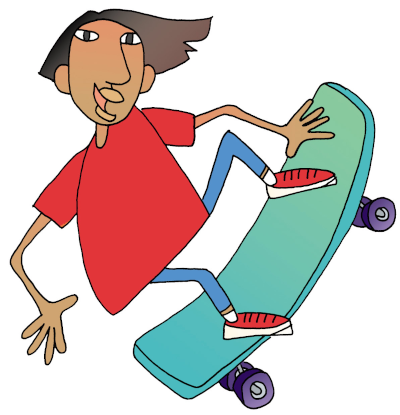Page 99
Understanding Writing Terms and Techniques

“Dude, wanna learn to do an ollie? How about a frontside 180? Can you do a tic-tac?”
Strong skateboarders learn lots of tricks, and also the names for them.
Strong writers learn their own tricks: “Dude, wanna use some sensory details? How about an anecdote? Try some personification!” This chapter helps you learn some cool writing tricks—and know what to call them.
What’s Ahead
WE 100
Page 100
Developing a Sense of Style
Your writing style will grow strong and healthy if you follow this advice:
- Practice often. Keep a journal and write in it every day. This is one of the best ways to develop your writing style.
- Try different forms. Try poems and plays; write news stories and character sketches. Try your hand at a fantasy story. Each form of writing can help you develop your style.
- Write about ideas that are important to you. If you write about topics that you care about, you will soon have a style of your own.
- Use your voice. Write with words you understand—words that sound like you.
- Change writing that doesn’t work. If you don’t feel good about your writing, fix it. Your handbook is full of ideas to help you do this.
- Learn about the qualities of effective writing. Qualities such as structure, ideas, and conventions ought to be part of your style, no matter what form your writing takes. (See pages 21–33.)
- Use writing techniques. The writing techniques listed on pages 101–104 can help you add color and variety to your style.
Express Yourself
Here’s an activity to help you strengthen your writing style. Pick five sentences from something you've written. Then try to make each sentence better by using a more lively verb or a more specific noun.
WE 101
Page 101
Using Writing Techniques
Writing techniques can be used to add interest to your style. Try a technique or two each time you write.
Anecdote 🟪 An anecdote is a brief story used to make a point. Here’s an anecdote that student writer Devon Johnson included in one of his essays.
You’ve got to stay positive. One day, I made a snowman in my backyard. During the night, somebody knocked it down. I was really mad, but my big brother said, “Let’s make it better.” We went out and shaped that fallen-down snowman into the long body of a dragon. A snow dragon! We made him a neck and head and wings and even sprayed water and green food color to make his scales. That night I saw some kids out there. I was going to chase them off, but they were taking pictures!
Try this: Use anecdotes in your writing when a little story can get your point across to your readers.
Colorful Adjectives 🟪 Colorful adjectives are lively words that describe nouns or pronouns.
Dad said I wrote a good story. (bland adjective)
Dad said I wrote an exciting, intriguing story. (colorful adjectives)
Try this: If you’re writing about food, think of words that make your mouth water when you say them.
Comparison 🟪 A comparison shows how two things are similar. Comparisons can be used throughout a long piece of writing. (See pages 181–188. Also see simile and metaphor.)
Pets and their people both have personalities and opinions.
Try this: Use comparisons to make your writing clearer or more colorful. A well-written comparison paints a picture with words.
WE 102
Page 102
Details 🟪 Details are the specific facts, examples, and words used to support a main idea and add color to your writing.
Jana was nice. (few details)
Jana gave me a fresh-picked daisy because I looked sad. (effective details)
Try this: When you are writing, use details that are specific and clear. Try to stay away from words like good, is, and nice because they are not specific and clear.
Dialogue 🟪 Dialogue lets people in your writing speak for themselves.
“What’s this?” I asked, looking at the daisy in my hand.
Jana replied, “I picked it for you.”
“Why?”
She shrugged. “Daisies make me happy. And you look sad.”
Try this: Add dialogue to your stories and reports. (Dialogue in a report might be from an interview.) It adds energy to your writing and makes your style memorable. (See page 144.)
Exaggeration 🟪 When you exaggerate in your writing, you create characters or scenes that stretch the truth a bit. (Use exaggeration in stories and fables, but not in essays or reports.)
Human hunters from the east kept attacking the elephants. So they marched in a line along the human camps and pounded their flat feet so hard that the Great Rift Valley formed, stranding the hunters on the eastern side.
Try this: Think of an animal and its characteristics. (The sample above uses an elephant and its tremendous weight.) Then stretch or exaggerate these natural features, especially in tall tales or children’s stories.
WE 103
Page 103
Idiom 🟪 An idiom is a word or phrase used in a way that is different from its usual or dictionary meaning.
My missing assignment was the elephant in the room. (Elephant in the room refers to an awkward issue that people won’t talk about.)
Try this: Use idioms selectively to make your writing sound realistic. Idioms fit better in stories than in reports.
Metaphor 🟪 A metaphor is a figure of speech that compares two different things without using the word like or as.
When Angela starts working, she’s a regular furnace.
Try this: Think of two things that have something in common, such as their color, size, shape, or behavior. Here are some examples: a sprinter and a roadrunner, blue eyes and the ocean, springtime air and a baby’s breath.
Personification 🟪 Personification is a figure of speech in which an idea, object, or animal is given the characteristics of a person.
The open road called to us, promising adventure.
Try this: Use personification to add life to your writing. You have already used it if you’ve ever said, “The wind howled” or “My phone complained that its charge was low.”

WE 104
Page 104
Sensory Details 🟪 Sensory details are details that help a reader see, feel, smell, taste, or hear a subject.
Wind rattled the leaves, releasing a bright red cascade around me. The fallen leaves crunched with every step.
Try this: Use your senses to find words that will add sound, feeling, and color to your writing.
Simile 🟪 A simile is a figure of speech that compares two things using the word like or as.
His eyebrows bunched up like a raven about to take off.
Try this: Use similes to add word pictures to your poems, stories, and descriptive writing.
Specific Nouns 🟪 A specific noun is a word that names a certain person, place, thing, or idea. In the chart below, A nouns are very general, B nouns are more specific, and C nouns are very specific.
| Person | Place | Thing | Idea | |
| A | boy | outdoors | toy | celebration |
| B | cousin | park | puppet | holiday |
| C | Rich Jones | Yellowstone | Pinocchio | New Year |
Try this: To make your writing as clear as possible, use very specific nouns whenever you can.
Vivid Verbs 🟪 A vivid verb is a powerful word that gives the reader a clear picture of the action.
The tiny dog trembled and growled with barely contained fury.
WE 105
Page 105
Modeling the Masters
Young artists can learn a lot about art by studying the work of famous painters. And you can learn a lot about writing by studying the work of your favorite authors. When you come across sentences that you especially like, try writing a sentence of your own following the author’s pattern. This process is called “modeling.”
Guidelines for Modeling
- Find a sentence (or short passage) that you especially like.
- Select a subject for your writing.
- Follow the author’s pattern as you write about your own subject.
- Build your sentence one small section at a time.
One Writer’s Experience
Cayla enjoys Roald Dahl’s stories, so every once in a while she tries to write like him. Here is a sentence from Dahl’s book Danny the Champion of the World:
Grown-ups are complicated creatures, full of quirks and secrets.
Here is Cayla’s sentence about her own subject, but modeled after Dahl’s writing:
Cats are peculiar pets, full of sleepiness and craziness.
Express Yourself
Remember, you “model” other authors to give you ideas for your own writing. Don’t overdo it so that you end up with someone else’s style.
WE 106
Page 106
Understanding Writing Terms
The following list of writing terms can be used whenever you want to talk about writing—yours or your classmates’.
Argument Writing 🟪 Writing that develops an opinion.
Arrangement 🟪 The way details are “arranged” or organized in writing. (See pages 24–26 and 94 for more information.)
Audience 🟪 People who read or hear what you have written.
Body 🟪 The main part of the writing, which comes after the beginning and before the ending. The body contains the specific details that support or develop the main idea. (Sometimes called the middle.)
Brainstorming 🟪 Freely sharing or listing ideas in order to collect a variety of thoughts on a subject.
Cliché 🟪 A familiar word or phrase that has been used so much that it sounds stale and uninteresting. An example would be “as good as gold” or “as clear as day.”
Composition 🟪 A piece of writing similar to an essay.
Description 🟪 Writing that helps a reader see a subject clearly with specific details and colorful modifiers.
Diction 🟪 The level or kind of language a writer decides to use. In a story about everyday life, a writer may use informal, ordinary language. In a business letter, a writer will probably use formal, proper language.
Editing 🟪 Checking a piece of writing to make sure it contains complete sentences, effective words, and correct punctuation, grammar, and spelling.
Ending Sentence 🟪 The sentence that sums up the main point being made in a paragraph.
Explanatory Writing 🟪 Writing that explains, such as a report or research paper. (Sometimes called expository writing.)
WE 107
Page 107
Figure of Speech 🟪 A special way of describing a subject by comparing it to something else. (See metaphor, personification, and simile.)
First Draft 🟪 The first attempt at writing about a topic.

Focus/Main Idea 🟪 The specific part of a topic a writer chooses to concentrate on. For example, a piece written about Abraham Lincoln could focus on his education.
Form 🟪 The shape of writing—a poem, an essay, a report, a play, and so on.
Freewriting 🟪 Writing quickly to discover new ideas.
Grammar 🟪 The rules and guidelines for correctly using language in your writing and speaking.
Journal 🟪 A daily record of thoughts, feelings, and ideas.
Modifier 🟪 A word or group of words that describes another word or idea.
Narration 🟪 Telling a story or recalling an experience.
Objective 🟪 Writing that includes facts but no opinions or personal feelings.
Parallelism 🟪 Using similar words or phrases to express similar ideas: Josie scratched her head, bit her nails, and shrugged her shoulders.
Person 🟪 The angle or point of view from which a story is told.
First person: I, we (speaking)
Second person: you (spoken to)
Third person: he, she, it, they (spoken about)